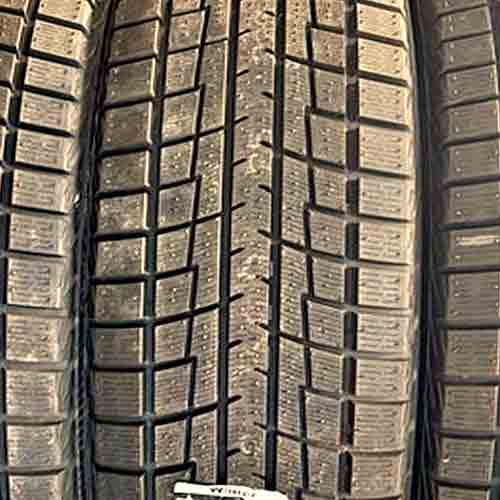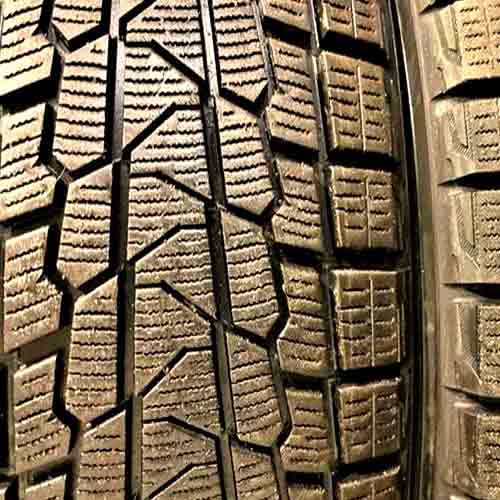Both Yokohama IceGuard IG52C and the Yokohama IG53 are formidable contenders in the frosty domain of winter tires, each showcasing unique grip and stability on slippery surfaces. As winter blankets the land, let’s find out who takes the top spot!

Table of Contents
Quick Takeaway
Yokohama IceGuard IG52 excels in:
- Directional Gripping: The IceGuard IG52’s interlocking lugs provide a larger contact area, resulting in better directional grip.
- Lateral Gripping: Thanks to its biting edges on shoulder lugs and narrower lateral grooves, the IceGuard IG52 significantly outperforms its counterpart in handling dry surfaces.
- Tread Life: With its lighter construction, the IceGuard IG52 has better tread life as its lugs create less friction and heat due to reduced ground pressure.
- Noise Generation: The IceGuard IG52, with its tread pattern having fewer voids, generates less noise.
- Wet Traction: Thanks to an advanced rubber compound, the IceGuard IG52 offers superior water dispersal abilities, enhancing traction on damp surfaces.
- Fuel Economy: The IceGuard IG52, with its lighter weight and longitudinally aligned ribs, offers better fuel efficiency.
Yokohama IceGuard IG53 excels in:
- Hydroplaning Resistance: The IceGuard IG53, with its interconnected tread voids or grooves, offers exceptional water channeling capabilities.
- Vibration Absorption: The next-generation compound of the IceGuard IG53 excels at absorbing disturbances from uneven surfaces.
- Ice & Snow Performance: The IceGuard IG53 offers superior performance on icy terrains and in lighter, powdery snow due to its advanced tread compound, biters, and open tread design.
Areas for Improvement:
- The Yokohama IceGuard IG52 could improve in hydroplaning resistance, vibration absorption, and ice performance, given its more minimalist approach to handling snow and lack of an advanced compound for absorbing disturbances.
- The Yokohama IceGuard IG53 could enhance its directional and lateral grip, tread life, noise reduction, and fuel economy, given its large longitudinal groove in the middle of the tread, thicker lugs with fewer biting edges, greater weight, and less streamlined lugs.
Ice And Snow Performance
The Yokohama IceGuard IG53 offers a noteworthy edge over its competition when navigating icy terrains, showcasing an impressive braking distance that is, on average, 11 feet shorter.
Such superior performance is attributed to the tire’s advanced tread compound, further enhanced by the strategically placed biters scattered across the tread. This high-quality tire also boasts an asymmetric pattern, significantly boosting its ice-gripping capabilities.
Additionally, the tire integrates a state-of-the-art rubber compound that works in harmony with the biters to deliver an unparalleled performance.
Notably, the Yokohama IceGuard IG53 shines in lighter, powdery snow, thanks to its open tread design. This innovative layout incorporates expertly crafted voids which effectively trap soft snow particles within the tread, providing superior snow-to-snow contact. This feature is crucial, as snow adheres more effectively to itself than to rubber.
In contrast, the Yokohama IceGuard IG52 employs a more minimalist approach to handling snow. Its compact tread design, characterized by aggressive, smaller biters, does not retain as much snow, resulting in slightly reduced performance in fluffier snow conditions.
Directional Gripping
The performance of a tire in terms of directional or longitudinal grip, a crucial factor for dry conditions, relies heavily on the design of the tread’s central area. This specific part of the tread bears the majority of the weight during straight-line driving.
When comparing the two tires in this aspect, it’s not surprising that the Yokohama IceGuard IG52 outperforms its counterpart by a significant margin.

To put it simply, this tire provides a larger contact area between the rubber and the road surface in the middle of the tread.
It achieves this through its interlocking lugs that effectively grip the road. In contrast, the IceGuard IG53 features a large longitudinal groove in that area, which results in longer braking distances during tests.
Lateral Gripping
The handling performance of a tire on dry surfaces depends largely on the design of its shoulder lugs and the overall flexibility of the tire.
And here, once again, the Yokohama IceGuard IG52 stands out as it significantly outperforms its predecessor, as the tire incorporates numerous biting edges on its shoulder lugs and narrower lateral grooves, working together to enhance grip.
On the other hand, the Yokohama IceGuard IG53 has thicker lugs with fewer biting edges, limiting its grip capacity.

Additionally, the heavier weight of this tire, during cornering, can lead to delayed oversteer and understeer responses, reducing its overall responsiveness to steering inputs.
Tread Life
The longevity of a tire’s tread is greatly influenced by rolling resistance, which is determined by the weight and design of the tread.
Simply put, lighter tires tend to have better tread life, as such tires exert less pressure on their lugs, as they rub against the road surface, reducing friction and slowing down the rate of wear.
Consequently, the Yokohama IceGuard IG52, thanks to its lighter construction, excels in tread life. Its lugs create less friction and heat due to reduced ground pressure, leading to greater wear resistance.
In contrast, the Yokohama IceGuard IG53 falls short in this regard due to its greater weight, less streamlined lugs, and outdated rubber composition. This puts it behind its newer counterpart, the IceGuard IG52.
Noise Generation
The noise produced by a tire is primarily a result of air particles colliding against the tread walls, and its volume can greatly impact the overall driving experience. Therefore, effective noise management is a key consideration in tire design.
In this regard, the Yokohama IceGuard IG52 takes the lead, thanks to its tread pattern with fewer voids. With fewer voids, there are fewer air cavities available for noise propagation, resulting in reduced noise as the tire rolls.
Fuel Economy
The fuel efficiency of a tire primarily depends on its interaction with the road surface and its overall weight. Both of these factors impact the tire’s rolling resistance, which significantly affects the vehicle’s energy usage.
In this regard, the Yokohama IceGuard IG52 stands out due to its lighter weight and longitudinally aligned ribs, providing better aerodynamic efficiency compared to the larger-spaced, and asymmetric pattern of the Yokohama IceGuard IG53.
As a result, the IceGuard IG52 enables smoother and more energy-efficient travel, especially during straight-line movements such as highway driving, for the most part.
Wet Traction
A tire’s performance on wet surfaces depends on its tread design and rubber composition. In this aspect, the Yokohama IceGuard IG52 surpasses its competitors in various factors, including grip, handling.
The tire utilizes an advanced rubber compound, that offers superior water dispersal abilities, significantly enhancing traction on damp surfaces, where the multi-angled sipes, further that.
Though in case of resistance to hydroplaning, the IG53 takes the upper hand, with its interconnected tread voids or grooves provide exceptional water channeling capabilities in all directions. And so you get higher speeds in both straight-line and curved aquaplaning testing situations.
Vibration Absorption
Tires act as the first line of defense against road irregularities and function as secondary suspension systems for vehicles. And in this context, the Yokohama IceGuard IG53 excels with its next-generation compound.
When encountering uneven surfaces, the construction of the tire adeptly absorbs all sorts of minor disturbances, delivering a smoother ride.
Though in defense of IG52, its lighter weight offers better steering feedback, offering a more refined ride experience still.
So one can rate both these tires equally.
So What’s the Verdict?
In summary, both the Yokohama IceGuard IG52 and IG53 present distinct advantages.
The IG52 excels in dry grip, handling, tread life, noise reduction, and wet traction due to its superior design features.
Conversely, the IG53 stands out in icy conditions and snow handling, offering better vibration absorption, yet falls short in areas like dry grip, tread life, and fuel efficiency.
Both have their unique strengths making the choice between them dependent on specific user requirements and driving conditions.